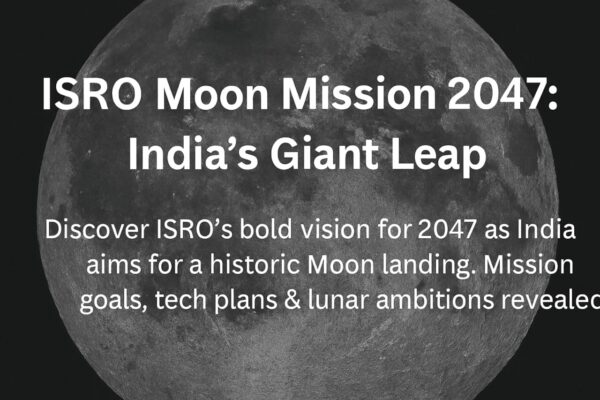India’s Vision 2047: Human Moon Landing Mission Marks a New Era in Space Exploration
India is setting its sights higher than ever before—toward the Moon. As part of the nation’s long-term space vision, India plans to land humans on the Moon by 2047, coinciding with the 100th anniversary of independence. This bold objective, championed under “Mission 2047,” reflects Prime Minister Narendra Modi’s commitment to making India one of the world’s foremost spacefaring nations.
Former ISRO Chief S. Somanath recently shed light on the roadmap, calling the 2047 lunar goal “the next logical leap” for India after the success of Chandrayaan-3. The mission represents not just a technological milestone but a defining chapter in India’s space story—linking national pride, innovation, and strategic capability.
India’s Lunar Journey So Far
India’s journey to the Moon has been both inspirational and groundbreaking. The Indian Space Research Organisation (ISRO) made its first mark with Chandrayaan-1 in 2008, discovering water molecules on the lunar surface. This discovery fundamentally altered the world’s understanding of the Moon’s geology.
In 2019, Chandrayaan-2 advanced India’s lunar ambitions further with an orbiter, lander, and rover. Though the lander Vikram faced challenges during descent, the orbiter continues to transmit vital data even today.
But it was Chandrayaan-3 (2023) that made history—India became the first nation to land near the Moon’s south pole, a region rich in scientific potential and untapped resources. The success captured global attention and placed ISRO alongside elite agencies such as NASA, Roscosmos, and CNSA.
Building on this legacy, ISRO has green-lit Chandrayaan-4 and Chandrayaan-5, which will focus on lunar surface exploration, sample return technology, and advanced robotic operations—key stepping stones toward a human Moon mission.
Gaganyaan: Laying the Foundation for Human Spaceflight
Before India can place humans on the Moon, it must first master the complexities of sending and sustaining astronauts in space. That’s where the Gaganyaan program comes in—a critical precursor to the lunar endeavor.
Under Gaganyaan, India plans to send its first crewed mission to low-Earth orbit by 2027, following a series of uncrewed test flights beginning in 2025. These missions will test crew modules, life-support systems, and emergency recovery mechanisms. The astronauts, known as “Vyomnauts,” are undergoing rigorous training in collaboration with international partners.
Gaganyaan’s success will establish India’s credibility in human spaceflight and pave the way for long-duration missions needed for lunar exploration.
Bharatiya Antariksh Station: India’s Own Space Outpost by 2035
In parallel with human spaceflight, ISRO is preparing to build India’s first indigenous space station—the Bharatiya Antariksh Station—by 2035. This orbital outpost will accommodate multiple astronauts for extended periods, allowing for biological, material, and microgravity research crucial to future Moon missions.
The station will serve as a stepping stone to the Moon, providing a platform to test life-support systems, docking mechanisms, and crewed spacecraft operations—technologies essential for safe lunar missions.
Mission 2047: The Road to the Moon
Mission 2047 encapsulates India’s broader ambition of becoming a developed, technology-driven nation by its centenary of independence. The human Moon mission forms a key pillar of this vision, alongside advances in defense, digital infrastructure, and artificial intelligence.
ISRO’s plan involves multiple stages:
- 2025–2027: Gaganyaan uncrewed and crewed flights.
- 2030–2035: Deployment of Bharatiya Antariksh Station and advanced lunar robotic missions.
- 2038–2042: Technology demonstration for deep-space human transport, life support, and re-entry.
- 2047: India’s first crewed lunar landing, marking the ultimate celebration of Viksit Bharat 2047.
This roadmap ensures progressive learning while leveraging private partnerships through India’s expanding space-tech ecosystem, including startups like Skyroot Aerospace, Agnikul Cosmos, and Bellatrix.

Also Read – Grokipedia: Elon Musk’s AI-Powered Wikipedia Alternative – 2025
Economic and Strategic Impact
India’s entry into human lunar exploration isn’t merely about national pride—it carries profound economic and strategic implications.
The global space economy, valued at $613 billion in 2024, is projected to exceed $1 trillion by 2032. India aims to capture 10–12 percent of this market through cost-efficient launch vehicles, indigenous satellite manufacturing, and advanced data services.
Furthermore, a successful ISRO lunar mission will enhance India’s role in international collaborations, positioning the country as a reliable partner in global scientific initiatives. Beyond prestige, it will stimulate domestic innovation, high-skill employment, and foreign investment in aerospace technology.
Strategically, human lunar capability enhances national security and technological self-reliance, ensuring India remains at the forefront of the world’s space powers.
Private Sector Participation and Global Cooperation
ISRO’s evolving policy now encourages private participation in all aspects of space activity—from manufacturing to launch and mission design. Companies like Larsen & Toubro, HAL, and NewSpace India Ltd. are expected to play vital roles in the 2047 roadmap.
On the global front, India’s partnerships with NASA (Artemis Accords), JAXA, and the European Space Agency will foster technology exchange and training for lunar surface operations, habitat design, and long-term sustainability.
These collaborations represent a blend of “Make in India” and “Collaborate with the World,” a dual approach that can fast-track progress while preserving India’s autonomy in space exploration.
Scientific and Social Significance
Beyond science and economics, the mission carries symbolic weight. The image of an Indian astronaut planting the tricolor on the Moon with the words “Viksit Bharat 2047” will echo globally as a declaration of progress, unity, and self-reliance.
Educationally, such milestones inspire future generations to pursue careers in STEM fields, fueling innovation and technological literacy across India. The Moon landing thus becomes not just a mission for ISRO, but a mission for every aspiring young Indian scientist and engineer.

Also Read:– Suzuki E-Vitara Electric SUV India – Specs & Price
Conclusion
India’s target of a human Moon landing by 2047 stands as a visionary blend of ambition, science, and national pride. From Chandrayaan’s robotic triumphs to Gaganyaan’s human flights and the Bharatiya Antariksh Station’s development, each step brings the nation closer to realizing this monumental goal.
Supported by government vision and private innovation, ISRO’s Mission 2047 is set to redefine India’s place in global space exploration. By merging economic growth with scientific leadership, the nation’s journey to the Moon will not just mark another achievement—it will symbolize the dawn of a Viksit Bharat leading humanity into the next frontier of discovery.
For more such updates and latest news on cars and bikes stay connected to times.motormitra.in
Thank you ..


